The Real Picture of Dyslexia: 1 in 5
Political maneuvers, educational agendas, myths, and misinformation have created an inaccurate and unfortunate picture of dyslexia.
Culturally, we tend to identify “dyslexia” as an uncommon and profound failure in reading, often related to a vision issue, that it is so crippling that it needs to be diagnosed as a “learning disability.”
If there is enough evidence of disability (and enough legislative and legal pressure), then a school may agree that a student “qualifies” for nonspecific “help” in special education services.
The unfortunate message is that dyslexia is a rare and obviously disabling deficit that can best be addressed through scarce school services.
More than two million children in the US with dyslexia would benefit from help; yet, only 3% are identified as qualifying for services for a “specific learning disability”.
This means that millions with dyslexia fall through the cracks. They don’t get the message that they have a healthy brain difference with reasonable, normal needs in learning.
Instead, the message about dyslexia is:
- They just need to try harder…
- They’ll outgrow it…
- But they don’t get their bs and ds mixed up…
- If you would only read more to your kid…
- Well, we all can’t be book smart…
- Quit being a helicopter parent…
- They are only a couple levels below…
- They get good grades, so there is no problem…
- They check out in class and won’t try…
- Your expectations for your child are unreasonable…
- You think that’s bad? You should see some of the other kids….
- They just don’t want it badly enough…
- College isn’t for everyone…
- Maybe they should rethink wanting to be a writer/doctor/scientist…
- They aren’t motivated…
- I outgrew dyslexia, so they can, too…
- Maybe your kid is not as smart as you think they are…
Some with dyslexia succeed wildly despite the messages they shouldn’t, some endure their education and land softly, and some crash with a sickening thud.
The message we should be sending is this: Dyslexia is a healthy and common brain difference that has strengths and weaknesses.
One in five people have “dyslexia”. This brain difference has a vast and multifaceted spectrum that is inadequately described in one word.
Like all brain types, this brain type has weaknesses…
These weaknesses are not related to intellectual disability, poor effort, or sensory impairment. The weaknesses (and strengths) of dyslexia are neurotypical for this brain type. All brain types have strengths and weakness. One brain type is not better than another. In fact, the diversity of brain types among people is critical for our existence.
The neurotypical difference of dyslexia can cause varying degrees of difficulty in developing skills in phonological awareness and rote memory. Phonological awareness is the skill to think about language so that one can pay attention to, discriminate, manipulate, and remember speech sounds. It is an essential skill for reading text in English, and without conscious development of this skill, those who are not proficient in this skill may struggle with print in reading, writing, math, and other related activities.
Sometimes, challenges with dyslexia will make school extremely difficult and recognizable as an obvious problem with print learning as early as kindergarten. This is the most common understanding and expectation of dyslexia, but this is rarely the case.
Sometimes, the challenges of dyslexia are masked for long periods of time by intelligence and compensatory learning skills. This leaves us scratching our heads as to why a bright learner starts to struggle in middle school, high school, or even college. The most common thing to do is to dismiss this unexpected performance as a lack of effort, intelligence, or motivation, but this is rarely the case. Most of the time, it is unmet needs related to unidentified dyslexia.
Like all brain types, this brain type also has strengths…
Beyond anecdotal abundance, research has concluded that those with dyslexia have advantages that include strengths in visual-spatial awareness, narrative thinking, pattern recognition, holistic perception, image-based thinking and recognition, creative thinking and problem solving, visual acuity with peripheral vision, critical thinking and analysis, and oral language comprehension.
The strengths with those of dyslexia get ignored because of unproven, unsupported, and misinformed approaches in education. Learning science does not support the effectiveness of text-based learning and testing; yet almost the entire educational system is based upon this false notion. This not only impacts those with dyslexia, but it also impacts all learners.
Reading science does not support the current and prevailing approaches of instruction for the general population and is woefully inadequate for those with dyslexia. Less than 3% of those with dyslexia have access to special education services. Of those who do qualify for services, regardless of legislation and mandates, the services delivered are rarely specifically for dyslexia or delivered with the fidelity and intensity required. As a result, very few learners with dyslexia exit special education services closing the “gap” despite years of intervention.
While we insist on learning through text, without providing appropriate access to text, we are forcing those with dyslexia to participate in education in ways that only highlight their weaknesses, while denying them the discovery, development, and use of their strengths.
LexiAbility appreciates the struggles that accompany dyslexia and we celebrate its strengths, too.
LexiAbility understands the “real picture” of dyslexia. This balanced and research-based perspective is essential to our positive approach and our success with effective services and resources for those with dyslexia.

